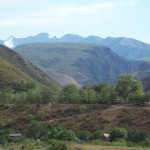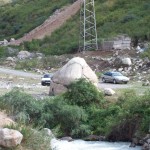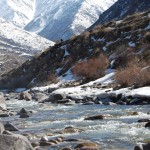We just got back from a trip to the Kyrgyz Republic (a Central Asian country more commonly known by its old name, Kyrgyzstan) for the last part of March and the first part of April 2012, so I thought it might be fun to post a brief “history of.”
The Kyrgyz Republic was one of the ‘stan’ countries in Central Asia under the Soviet Union. Stan means both ‘place of’ (so place of the Kyrgyz) and ‘settlement.’ When the Soviets came to power in Central Asia in the early 20th century they organized the area, which had been conquered repeatedly by various empires throughout history, into states based on ethnic and geographical criteria. Kyrgyzstan was thus born under their rule.
The country was formed around the Kyrgyz people who were nomadic shepherds and occasional warriors. Their origins are obscure. They appear to have emigrated from the north, perhaps from as far north as present day Russia, most likely from Siberia. Legend has it that they had fair skin, red hair and green eyes. This is much different than the Asian/Eurasian appearance of the Kyrgyz people today.
By the 12th century when the Kyrgyz had completed their gradual migration south to present day Kyrgyz Republic, the region had already been populated for thousands of years. Empires had repeatedly stretched to their limits in the area of Central Asia. The Scythians were the first known group to enter and control modern day Kyrgyz Republic. The Huns came through next followed by the Turks who were eventually conquered by Arab Muslims. The Arabs brought Islam, which is still the dominant religion in Central Asia and the Kyrgyz Republic, to the region and repelled the invasion of the Chinese in the 8th century which halted their western expansion. Islam was also brought to the region from merchants on the Silk Road which passed through the Kyrgyz Republic for hundreds of years.
The Kyrgyz adopted a version of Islam which they paired with their current religion of Shamanism. To this day many Kyrgyz, particularly in the north, practice some of the traditions of Islam, like not drinking, without fully embracing the religion and going to mosques on a regular basis.
The best known conqueror of Central Asia was Genghis Khan who tore across the Central Asian steppe and over the high mountains of present day Kyrgyz Republic, destroying or subduing everyone in his path in the 13th century. The Kyrgyz people resisted Khan and his armies and were almost wiped out as a result. There are hardly any buildings or records in the Kyrgyz Republic and Central Asia that predate the Mongol invasion. Timur the lame followed Genghis Khan in the 14th century as conqueror and ruler.
In the 17th century the Russians were already becoming more involved in Central Asia through trade. Prior to the Soviet Union take over, they had developed a loose control of Central Asia. They Kyrgyz revolted in 1916 and lost a third of their population to China (those who fled) and reprisal killings. When the Soviets came to power they exerted a much stronger control over the area, prohibiting the nomadic ways of the Kyrgyz, forcing them onto collectivized farms, conducting a number of purges in the late 1930s of intellectuals and dissidents, and forcing the Kyrgyz people to fight in World War II.
After the Soviet Union broke up, Kyrgyzstan declared its independence in 1991, the first Central Asian country to do so. It was not a violent event. There was no wall to be torn down in Kyrgyzstan. There were also no wild crowds pulling down statues. Over time Soviet statues were removed carefully with no sense of urgency. In fact, a statue of Vladimir Lenin is still up in one of the parks in the capital city of Bishkek. There was a peaceful transition to a fledgling democracy. Since the Soviets had created bureaucracy and infrastructure it was fairly easy to change leadership and slowly shift the bureaucracy to the natives.
Thus the new country of Kyrgyzstan, renamed the Kyrgyz Republic soon after independence, started out with much promise. Two heads of state began as reformers, but wound up enriching themselves and their allies and families. This corruption fueled two revolutions in 2005 and 2010. The Kyrgyz currently have a new government in power since 2010 that has held elections and is trying to make reforms to reduce corruption and create a lasting democracy.
If reforms can be enacted, the Kyrgyz Republic has great potential. It has natural resources like gold for mining, water for hydroelectric power, agriculture, and tourism possibilities (the mountains and Lake Issyk Kul). Additionally, they are once again a crossroads for great power rivalries. The United States, with its air base at Manas International Airport just outside Bishkek, vies with Russia and China for influence in the Kyrgyz Republic and Central Asia.
I’ve included some pictures we took in the Tien Shan Mountains just outside of the capital city of Bishkek.



